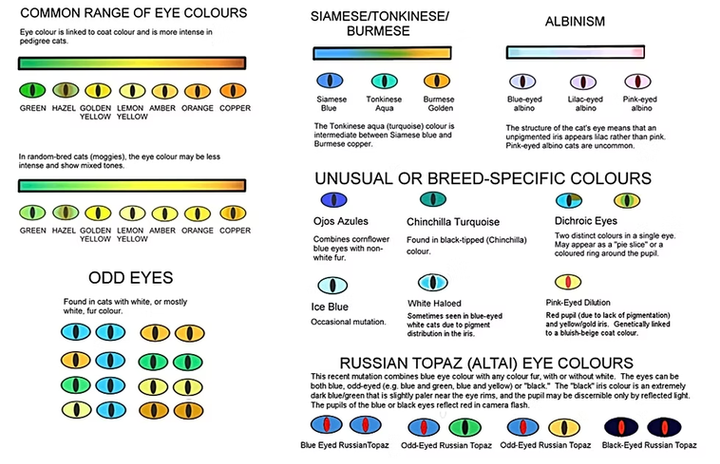
Cat phenotype and morphology
1. How to define a cat's coat
A cat's coat phenotype is defined by the combination of base colour, pattern and the distribution of any white markings. These elements are encoded by specific genetic loci, the combined expression of which generates a great diversity of coats.
In French-speaking cat breeding practices, coat nomenclature is a mixture of French terms for colours and English terms for patterns. For example: "Bleu mackerel tabby et blanc".
2. Coat phenotypy
In addition to the pattern of the coat, three main criteria also characterise the feline coat:
-
The length of the hair : short, medium-long or long, it is mainly determined by variations in the FGF5 gene, associated with the regulation of the hair cycle.

-
Coat density and texture : strongly influenced by polygenic factors, they vary according to breed and environmental adaptation.

-
The morphology of the tail : its length and shape depend on specific mutations, often specific to certain breeds. There is a natural variability which can be :
-
Long and tapering, often carried straight or in a plume, typical of natural breeds.
-
Short, bent or knotted, as in the Japanese Bobtail or the Kurilian, the result of specific mutations.
-
Absent or very reduced, as in the Manx, it can be explained by a natural mutation affecting caudal development.
-
The length, shape and insertion of the tail are generally determined by hereditary factors specific to each breed. They may also reflect natural variations without being associated with a pathological anomaly.


3. Eye colour
In contrast to the great variability of coat phenotypes, eye colour in the domestic cat (Felis catus) presents a more restricted but nonetheless well-characterised range. It results mainly from the concentration and distribution of melanin within the iris, under genetic control.
Role of melanin:
Melanin is a biological pigment produced by melanocytes from tyrosine through the action of the enzyme tyrosinase. It is involved in pigmentation of the coat, skin and eyes.
*** Translated with www.DeepL.com/Translator (free version) ***


The amount of melanin present in the iris determines the colour observed:
-
Low concentration: light blue to dark blue iris (almost total absence of melanin in the posterior epithelium of the iris, the blue colour resulting from light scattering - Tyndall effect).
-
Intermediate concentration: green to hazel irises.
-
High concentration: golden yellow, copper or dark amber irises.
Genetic and phenotypic correlations
Certain phenotypes or mutations are directly associated with a specific eye colour:
-
The colorpoint pattern (mutation of the TYR gene, responsible for tyrosinase thermosensitivity) leads to ocular hypopigmentation and therefore systematically blue eyes.
-
Irine mismatch (complete or partial irine heterochromia, or "minnow eyes") generally results from an asymmetric distribution of melanocytes, often linked to mutations affecting pigment cell migration, such as those seen in white cats (W gene) or piebald cats (S gene).
Indicative references:
-
Imes DL et al (2006). "Tyrosinase mutations associated with Siamese and Burmese patterns in the domestic cat." Anim Genet.
-
Gandolfi B et al. (2015). "The genetics of cat coat coloration and patterning." Annu Rev Anim Biosci.




